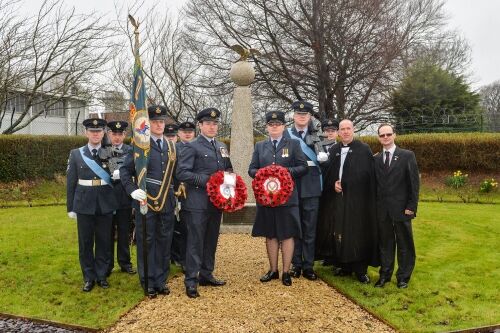
100 years of 45 (R) Squadron
Published:
Categories:
From its beginnings in the First World War to service in the skies above Iraq – 45(R) Squadron will mark their centenary this month.
This milestone was marked when 45 (R) Squadron revisited the site where life began 100 years ago. The ceremony at HMS Sultan saw the parading of the Squadron Standard, followed by the Officer Commanding, Wing Commander David Catlow laying a wreath to commemorate the dedication of their Squadron predecessors.
Another separate ceremony was held at a cemetery in Blyth to honour Major John Firth a former member of 45 (R) Squadron known for his heroic role as a fighter pilot in the First World War. A working party from the unit tended to the grave of Major Firth before laying a wreath and observing a minute's silence.
The Squadron began life in 1916 and quickly moved to France flying Sopwith 1½ Strutters on fighter patrols. Compared to other air services of its time, it quickly became outdated with the squadron being re-equipped with Camels the following year, which gave the Squadron its enduring nickname – the Flying Camels!
In December, the Squadron moved to Northern Italy for offensive patrols and ground attack operations. A year later the unit returned to France for the remainder of the First World War and back to the UK in February 1919.
Following a period of disbandment the Squadron reformed in Egypt on 1 April 1921 beginning an association with the Middle and Far East that lasted almost 50 years. In support of anti-rebel operations, their exercises were diverse and ranged from carrying out air mail duties to bombing rebel villages; they soon became known as a highly effective multi functional Squadron.
In April 1927, the unit became a bomber Squadron with their fleet of Harts, Vincents and Gordons being exchanged for Blenheims at the outbreak of the Second World War. When Italy joined the conflict in 1940 the Squadron moved to the Western Desert spending time in both Burma and India.
After the war, the Squadron spent 12 years in Operation Firedog, an anti- terrorist mission against Communist guerrillas. During the next 10 years the Squadron was disbanded several times during which the unit became involved in providing tactical weapons training.
The Squadron now encompasses the role of training weapons systems operators alongside training multi-engine pilots at RAF Cranwell. The King Air B200 is now used as an advanced, multi-engine pilot trainer by 45(R) Squadron.